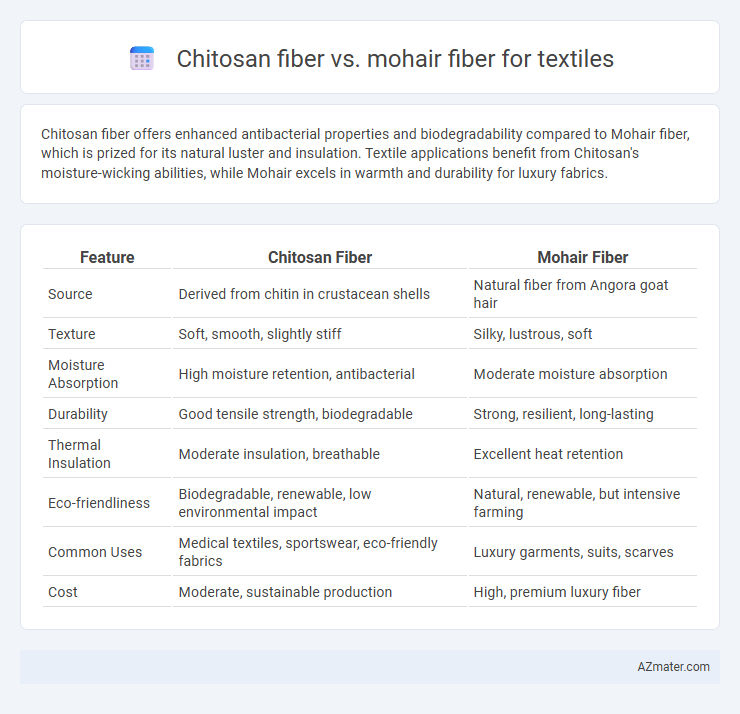Chitosan fiber offers enhanced antibacterial properties and biodegradability compared to Mohair fiber, which is prized for its natural luster and insulation. Textile applications benefit from Chitosan's moisture-wicking abilities, while Mohair excels in warmth and durability for luxury fabrics.
Table of Comparison
| Feature | Chitosan Fiber | Mohair Fiber |
|---|---|---|
| Source | Derived from chitin in crustacean shells | Natural fiber from Angora goat hair |
| Texture | Soft, smooth, slightly stiff | Silky, lustrous, soft |
| Moisture Absorption | High moisture retention, antibacterial | Moderate moisture absorption |
| Durability | Good tensile strength, biodegradable | Strong, resilient, long-lasting |
| Thermal Insulation | Moderate insulation, breathable | Excellent heat retention |
| Eco-friendliness | Biodegradable, renewable, low environmental impact | Natural, renewable, but intensive farming |
| Common Uses | Medical textiles, sportswear, eco-friendly fabrics | Luxury garments, suits, scarves |
| Cost | Moderate, sustainable production | High, premium luxury fiber |
Introduction to Chitosan and Mohair Fibers
Chitosan fiber, derived from chitin found in crustacean shells, offers exceptional biodegradability, antimicrobial properties, and moisture management, making it an innovative sustainable textile material. Mohair fiber, sourced from the Angora goat, is prized for its luster, softness, durability, and excellent thermal insulation, often used in high-end fashion and luxury textiles. Both fibers serve distinct applications in the textile industry, with chitosan focusing on eco-friendly performance and mohair emphasizing luxury and natural warmth.
Fiber Source and Production Methods
Chitosan fiber is derived from chitin found in crustacean shells, utilizing an eco-friendly deacetylation process to convert it into a soluble form suitable for spinning, promoting sustainable textile production. Mohair fiber originates from the Angora goat, obtained through shearing the fleece, and undergoes traditional cleaning and spinning methods that emphasize natural animal fiber characteristics. The biopolymer nature of chitosan offers antimicrobial properties, while mohair's protein-based fiber delivers luster and durability, each influencing production techniques in unique ways.
Physical Structure and Appearance
Chitosan fiber exhibits a smooth, glossy surface with excellent moisture absorption and antibacterial properties, making it highly suitable for functional textiles. Mohair fiber, derived from the Angora goat, features a lustrous, silky texture with a natural crimp that provides elasticity and warmth. The physical structure of chitosan fibers is more uniform and bio-based, whereas mohair fibers have a unique natural scale pattern contributing to a soft and luxurious appearance.
Mechanical Properties: Strength and Durability
Chitosan fiber exhibits superior mechanical strength and durability compared to traditional mohair fiber, making it highly suitable for demanding textile applications requiring long-lasting performance. The tensile strength of chitosan fiber often surpasses that of mohair, providing enhanced resistance to wear and tear under stress. Mohair fiber, derived from Angora goats, offers excellent elasticity but generally falls short in mechanical durability relative to the robust nature of chitosan-based fibers.
Moisture Absorption and Comfort
Chitosan fiber exhibits superior moisture absorption compared to mohair fiber due to its hydrophilic properties and ability to retain water molecules, enhancing overall fabric breathability and comfort. Mohair fiber, while naturally insulating and soft, has lower moisture-wicking capabilities, which may lead to reduced dryness during wear. The antimicrobial properties of chitosan further improve comfort by minimizing odor and skin irritation, making it a preferred choice for moisture management in textiles.
Antimicrobial and Hypoallergenic Qualities
Chitosan fiber exhibits strong antimicrobial properties due to its natural biopolymer structure, effectively inhibiting bacterial growth and reducing odors in textile applications. Mohair fiber, derived from the Angora goat, offers excellent hypoallergenic qualities with its smooth, non-irritating surface, making it suitable for sensitive skin but lacks inherent antimicrobial activity. Combining chitosan's antimicrobial efficacy with mohair's hypoallergenic softness can enhance textile performance for medical and allergy-friendly fabrics.
Sustainability and Environmental Impact
Chitosan fiber, derived from chitin found in shellfish waste, offers superior biodegradability and antimicrobial properties compared to mohair fiber, which is harvested from the Angora goat and involves intensive land and water resource use. The production of chitosan fiber supports circular economy principles by utilizing seafood industry byproducts, significantly reducing environmental pollution and waste. Mohair fiber's sustainability is challenged by animal welfare concerns and higher greenhouse gas emissions associated with livestock farming, making chitosan fiber a more eco-friendly choice for sustainable textile manufacturing.
Dyeing Affinity and Colorfastness
Chitosan fiber exhibits superior dyeing affinity due to its abundant amino groups that form strong ionic bonds with acidic and reactive dyes, resulting in vibrant and uniform coloration. In contrast, Mohair fiber, composed primarily of keratin protein, shows moderate dye uptake but often requires mordants to enhance dye affinity. Regarding colorfastness, chitosan fiber generally demonstrates excellent wet and light fastness owing to its chemical structure, while mohair's natural protein structure offers good but sometimes less consistent fastness, especially under prolonged light exposure.
Applications in the Textile Industry
Chitosan fiber, derived from chitin in crustacean shells, offers antimicrobial properties, biodegradability, and moisture management, making it ideal for medical textiles and eco-friendly fashion. Mohair fiber, produced from Angora goats, is valued for its luster, durability, and insulating properties, extensively used in luxury apparel, upholstery, and high-end textile blends. Textile manufacturers leverage chitosan fibers for functional clothing and hygienic applications, while mohair remains preferred for premium garments and decorative fabrics.
Cost Analysis and Market Availability
Chitosan fiber offers a sustainable alternative in textiles with moderate production costs influenced by raw chitin extraction, but faces limited market availability compared to mohair fiber, which commands higher prices due to its natural luxury status and established global supply chains. Mohair fiber benefits from well-developed production infrastructure, enabling consistent quality and availability despite price volatility linked to seasonal yields and regional farming conditions. Cost analysis shows chitosan fiber's potential for competitive pricing if scaled up, whereas mohair remains premium due to its rarity and processing demands.

Infographic: Chitosan fiber vs Mohair fiber for Textile
 azmater.com
azmater.com